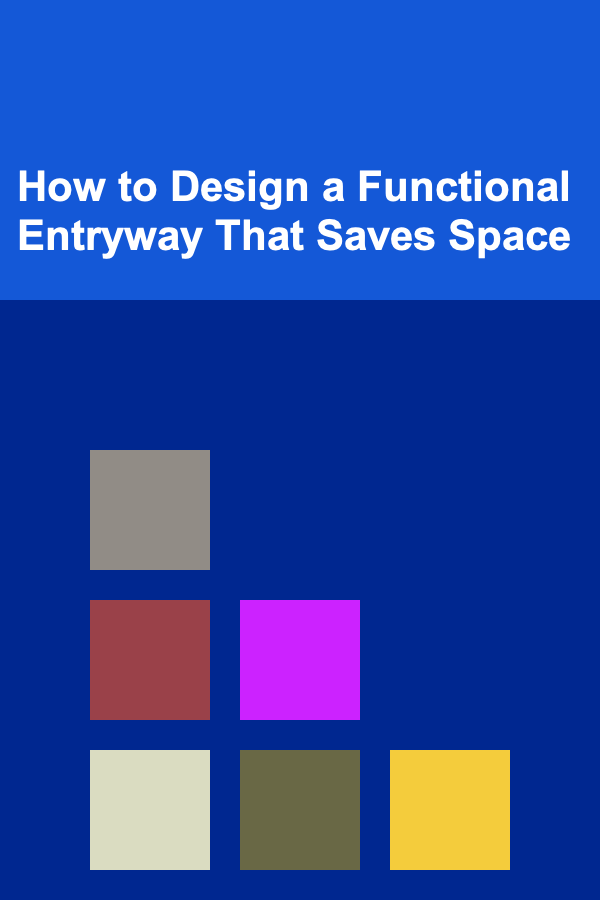
How to Design a Functional Entryway That Saves Space
ebook include PDF & Audio bundle (Micro Guide)
$12.99$9.99
Limited Time Offer! Order within the next:

The entryway, often referred to as the "landing zone" of the home, serves as the first impression for visitors and a crucial transition space for residents. Despite its importance, many homeowners overlook the significance of an organized and functional entryway. A well-designed entryway can enhance the flow of your home, provide essential storage solutions, and create an inviting atmosphere while maximizing limited space. This article delves into strategies for designing a functional entryway that saves space without sacrificing style or utility.
Understanding the Importance of an Entryway
Functionality and Purpose
The primary purpose of an entryway is to facilitate movement in and out of your home. It acts as a buffer between the outside world and your living space, providing a designated area for removing shoes, hanging coats, and storing bags.
Key Functions of an Entryway
- Organization: Keeps essential items like keys, bags, and outerwear in one place, reducing clutter throughout the home.
- Convenience: Provides easy access to frequently used items, streamlining daily routines.
- Aesthetic Appeal: Sets the tone for your home's interior design, offering a welcoming first impression.
Challenges of Small Entryways
In smaller homes or apartments, the entryway may feel cramped or underutilized. Common challenges include:
- Limited Space: Smaller entryways often lack sufficient square footage for traditional furniture pieces.
- Clutter Accumulation: Without proper organization, shoes, bags, and other items can quickly contribute to chaos.
- Inadequate Storage: Finding ways to incorporate storage solutions while maintaining accessibility can be challenging.
Assessing Your Entryway Space
Before diving into design ideas, it's essential to assess your current entryway. Evaluating the available space will help tailor solutions to your specific needs.
1. Measure Your Space
Accurate measurements are vital for planning. Use a measuring tape to take note of:
- Dimensions: Measure the length, width, and height of your entryway, including doorways and ceilings.
- Obstructions: Identify any architectural features, such as windows, radiators, or columns, that might impact design choices.
2. Identify Usage Patterns
Observe how you and your family use the entryway on a daily basis. Consider:
- Traffic Flow: Note where people typically enter and exit, and how they navigate through the space.
- Item Placement: Pay attention to where shoes, bags, and other items tend to accumulate, indicating areas that require dedicated storage.
3. Define Your Needs
Consider the specific needs of your household, including:
- Number of Users: The more people using the entryway, the more storage solutions you'll require.
- Seasonal Variations: Think about whether your needs change with the seasons (e.g., heavy winter coats vs. lighter jackets).
Effective Space-Saving Strategies
Designing a functional entryway that saves space requires creativity and careful planning. Here are several strategies to consider:
1. Multi-Functional Furniture
Investing in multi-functional furniture can significantly optimize your entryway space.
Bench with Storage
A bench provides a convenient seating area for putting on or taking off shoes while offering hidden storage for items like extra shoes or bags.
- Built-In Options: If possible, opt for built-in benches that seamlessly integrate into the design of your home.
Foldable Chairs
If space allows, consider foldable chairs that can be tucked away when not in use, providing flexibility for larger gatherings.
- Compact Design: Choose lightweight options for easy relocation.
2. Vertical Solutions
Maximizing vertical space is key to saving room in small entryways.
Wall-Mounted Shelves
Installing shelves above eye level can free up floor space while providing storage for decorative items or less frequently used belongings.
- Adjustable Shelving: Opt for adjustable shelf systems that allow customization based on changing needs.
Hooks and Racks
Using wall-mounted hooks or racks for coats and bags keeps items off the floor and within reach.
- Variety of Styles: Choose from various styles, materials, and colors to match your decor.
3. Clever Storage Solutions
Finding creative storage solutions is essential for maintaining a tidy entryway.
Under-Bench Storage Bins
If you have a bench, utilize the space beneath it with bins or baskets that blend with your decor.
- Labels: Label bins to categorize contents and ensure easy access.
Over-the-Door Organizers
Use the back of the entryway door for additional storage options, such as shoe organizers or hooks for bags.
- Discreet Design: Look for slim designs that don't interfere with door operation.
4. Use of Mirrors
Mirrors serve both functional and aesthetic purposes in an entryway.
Space Illusion
A large mirror can create the illusion of a larger space by reflecting light and making the area feel more open.
- Entryway Focus: Position mirrors where they can reflect natural light or create visual interest.
Utility
Mirrors also provide a convenient spot for quick appearance checks before leaving the house.
Creating Zoning Areas
Zoning refers to dividing your entryway into distinct functional areas, helping streamline organization.
1. Designated Storage Zones
Establish specific zones for different types of items to maintain order in your entryway.
Shoe Zone
Create a designated area for shoes, ensuring that footwear is stored neatly and easily accessible.
- Shoe Racks: Utilize vertical shoe racks or cubbies to keep the area organized.
Bag Zone
Set aside hooks or shelves specifically for bags, backpacks, and purses to prevent clutter.
- Easy Access: Ensure hooks are at a height that accommodates all users.
2. Seasonal Rotation
Implement a system for seasonal items to ensure that everything remains relevant and accessible.
Seasonal Storage Solutions
Use storage bins for seasonal items---such as heavier coats for winter or lighter jackets for summer---while keeping current necessities within easy reach.
- Labeling System: Clearly label bins to facilitate swift transitions between seasons.
3. Visual Cues
Creating clear visual cues can help maintain order and encourage family members to put items away properly.
Color Coding
Utilize color coding for different zones (e.g., blue for bags, green for shoes) to make organization intuitive.
- Matching Accessories: Use matching bins, hooks, or labels in each colored zone to reinforce organization.
Personalizing Your Entryway
While functionality is crucial, personal touches can enhance the appeal of your entryway.
1. Design Style
Choose a design style that reflects your personality and complements the rest of your home.
Cohesive Decor
Ensure that the colors, materials, and overall design of your entryway align with your home's aesthetic.
- Accent Colors: Introduce accent colors through accessories like rugs, artwork, or plants.
2. Lighting
Proper lighting enhances the ambiance and functionality of your entryway.
Layered Lighting
Employ layered lighting techniques that combine ambient, task, and accent lighting.
- Wall Sconces: Install wall sconces alongside mirrors or artwork to create a welcoming atmosphere.
3. Greenery and Decor
Incorporate plants or decorative elements that resonate with your style.
Indoor Plants
Use low-maintenance indoor plants to add life and vibrancy to your entryway.
- Decorative Pots: Choose decorative pots that match your theme while providing necessary drainage.
Artwork and Personal Items
Display personal artwork, family photos, or souvenirs to create a warm and inviting space that tells your story.
- Gallery Wall: Consider creating a small gallery wall with framed images and art for added interest.
Sustainable Solutions
Integrating sustainable practices into your entryway design can benefit both the environment and your home.
1. Eco-Friendly Materials
Opt for eco-friendly materials when selecting furniture, flooring, and decor.
Sustainable Furniture
Look for furniture made from recycled materials or sustainably sourced wood.
- Local Artisans: Consider purchasing from local artisans to reduce the carbon footprint associated with transportation.
2. Energy Efficiency
Explore energy-efficient lighting options to reduce electricity consumption in your entryway.
LED Lighting
Switch to LED bulbs for task and ambient lighting, which consume less energy and last longer than traditional bulbs.
3. Natural Fiber Rugs
Choose rugs made from natural fibers, such as jute, wool, or organic cotton, for an eco-friendly touch.
- Biodegradable Options: These materials decompose naturally, minimizing environmental impact.
Maintenance and Adaptation
Once your entryway is designed, ongoing maintenance is essential to keep it organized and functional.
1. Regular Decluttering
Implement a routine for decluttering your entryway to prevent it from becoming overwhelmed.
Monthly Reviews
Schedule monthly reviews of items stored in your entryway, removing anything that no longer serves a purpose.
- Donation Box: Keep a donation box handy for easy disposal of items you no longer need.
2. Flexibility in Design
Be open to adapting your entryway layout as your needs change over time.
Seasonal Adjustments
Reorganize seasonal items and adjust furniture placement based on changing activities or requirements.
- Feedback Loop: Encourage family members to provide feedback on the functionality of the space, allowing for continuous improvement.
Conclusion
Designing a functional entryway that saves space is a rewarding process that enhances the overall efficiency and aesthetic appeal of your home. By understanding the importance of the entryway, assessing your space, and implementing creative storage solutions, you can create a welcoming and organized environment that meets your family's needs.
Whether you're working with a large foyer or a compact corner, the principles outlined in this guide will help you maximize every inch while maintaining a stylish and practical entryway. With thoughtful planning, personalization, and adaptability, your entryway will become a harmonious transition space that sets the tone for the rest of your home---a functional hub that reflects your lifestyle and welcomes both you and your guests.

Effective Strategies for Talent Acquisition Specialists: Building Strong Talent Pipelines
Read More
How to Invest in Cryptocurrency for the Long-Term
Read More
How to Master Comparison Shopping Before Making a Purchase and Save Big
Read More
How to Sell Used Power Tools on Facebook Marketplace: An Actionable Guide
Read More
How to Use Hidden Storage in Furniture to Keep Your Home Clutter-Free
Read More
The Tax Consultant's Guide: Mastering Tax Strategies for Individuals and Businesses
Read MoreOther Products

Effective Strategies for Talent Acquisition Specialists: Building Strong Talent Pipelines
Read More
How to Invest in Cryptocurrency for the Long-Term
Read More
How to Master Comparison Shopping Before Making a Purchase and Save Big
Read More
How to Sell Used Power Tools on Facebook Marketplace: An Actionable Guide
Read More
How to Use Hidden Storage in Furniture to Keep Your Home Clutter-Free
Read More